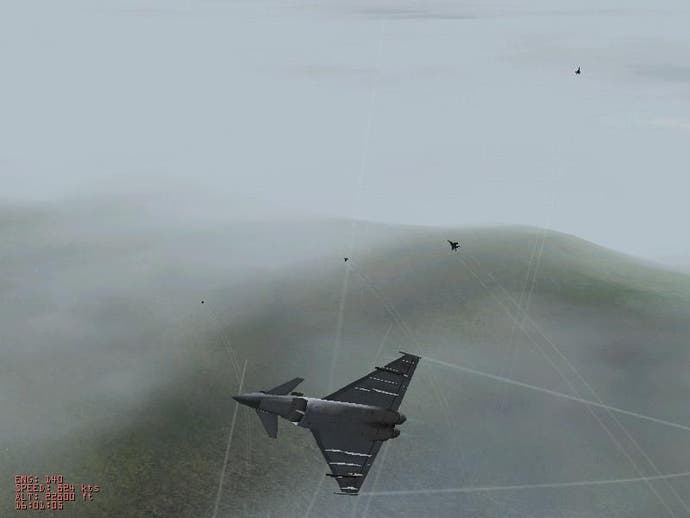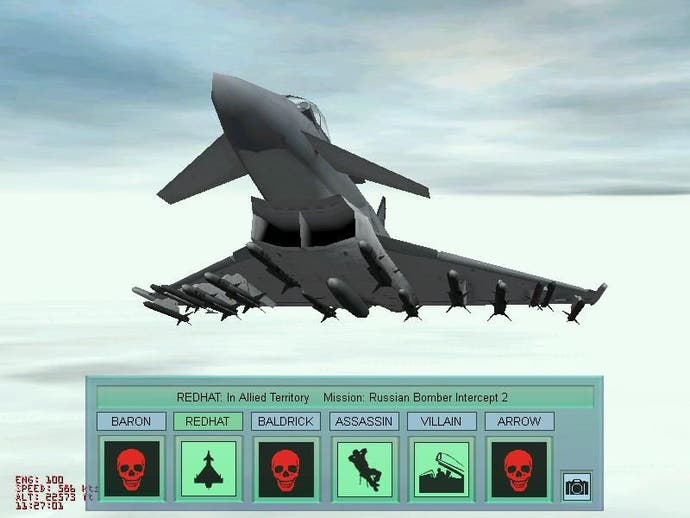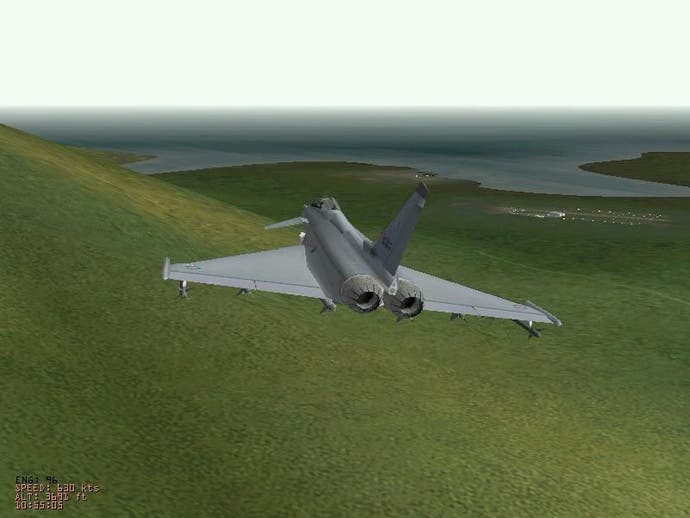EuroFighter Typhoon
Preview - a hands-on look at the new jet fighter sim from DID and Rage
Eurofighter Typhoon is a flight simulator designed to appeal to the Tomb Raider generation - attractive, simple and compelling. It is intended to bring a whole new audience into military flight simulation, while allowing the hardcore crowd to enjoy a day off from complex radar modes and weapon profiles.
With the recent arrival of the first beta code from publisher Rage, EuroGamer scrambled its resident flight sim fanatic Ian Boys to take a closer look...

And Now For Something Completely Different
EuroFighter represents a major departure from DID's previous offerings, such as EF2000 and F-22 Total Air War, in that the multifarious option screens, key combinations and menus have been replaced by a simple system that would happily fit onto a PlayStation gamepad. It retains, however, the thrill of fast jet combat and adds new levels of immersion through its innovative campaign system.
The interface is reminiscent of a simple shoot 'em up, with big boxes and few options. The player has three choices - War Campaign, Peace Campaign and Multiplay. The War Campaign is fairly obvious, while the Peace Campaign is actually much the same, except that it starts half an hour earlier and so allows new players to gain a passing familiarity with the aircraft and navigation systems before the shooting starts. Multiplay offers several modes designed to appeal to newcomers to the flight sim genre, including imaginative racing and Capture the Flag type games alongside the more traditional dogfights and five cooperative missions.
Glaringly absent at this stage though is any kind of quick mission builder or single mission option. The only way to play is to go through the campaigns from the beginning, slowly progressing through the simpler missions to the meat of the game. It is, I think, nothing short of incredible that in a simple game like this there is no way to jump in and enjoy a quick dogfight, which is what the game does best! Some of the multiplayer missions can be enjoyed offline, but it's just not the same.

Protecting Your Pilots
The campaign represents an invasion of Iceland by Russian forces in 2015 in which the Eurofighters are the island's primary defence, although Tornados and other aircraft are also present. Iceland has been cut off from the outside world and as such there is no respawning or replacement of your pilots or aircraft, so what you have has to last.
At the outset of the game the player chooses six pilots of varying skills, health and abilities and these become your flight leaders for the squadrons spread around Iceland. And unlike Falcon 4, where the death of an individual pilot is of no great consequence, the necessity to play through the persona of one of these six flight leaders will make you very protective and force you to weigh up the value of every target. Should you risk killing a submarine that carries protective armament? Should you wait and engage the Migs over Iceland in case you have to bail out, or should you take the fight out over the icy ocean? Can you afford to lose your single Wild Weasel (Suppression of Enemy Air Defences) specialist?
The game is played out in real time and you can see your six pilots relaxing in the mess hall, getting briefed and planning missions. If the mission goes according to plan your pilots get debriefed and earn medals. If not they can end up adrift in the freezing sea, hiding out on a hillside waiting for evacuation or in hospital. If it goes really badly they can be captured and interrogated, or even killed. As the campaign progresses you will be urging that Chinook helicopter on as it goes to the rescue of one of your pilots in no man's land, even as you race overhead on the way to bomb another target.
The realistic campaign begins with a Russian softening-up strike in which bombers and a submarine fire cruise missiles at your bases and facilities in Iceland. This phase is fairly simple and missile interception missions let the new player practice simple dogfighting techniques. This is followed by Russian airstrikes and you will soon be flying non-stop combat air patrols. Shortly afterwards the first waves of marines land in ekranoplanes (already in use in the Caspian Sea) and the invasion has begun. You are treated to a map of Iceland carved into sectors and your role thereafter is to prevent too many of those becoming red through determined bombing and counter-attacks. The campaign is very well designed and lends weight to the feeling that your squadrons are the deciding factor in the war. It's just a pity that there is no shortcut to the more interesting missions for when you want to play for a quick half hour or so.

Graphics And Sound
Virtual Iceland is, like the real thing, a bare and hostile place. The terrain is attractive but not spectacular, though it offers some deep valleys and sharp ridges to fight around. 3D objects are scarce, but that is not a major concern as it is SAM sites and tanks that are the main focus of your attentions, not factories or bridges.
Weapons, damage, smoke, explosions and other special effects leave nothing to be desired and the Eurofighter aircraft itself is lovingly modelled, with great use of lighting effects, especially on the canopy. By far the most impressive visual treat though is the sky. It is so far above every other flight sim out there that one wonders why developers have not modelled it nearly as well before, given that it is the very arena of flight sims. The interplay of light and clouds is very believable and helps immerse the player in this chilly northern world.
Because of the target audience there is no highly detailed cockpit; instead there is a single radar mode and targets can be automatically chosen by the computer with a single keystoke. Twelve weapons are available, representing most of the major weapons systems from laser-guided bombs to anti-shipping missiles, although anti-runway weapons will be sorely missed by those who remember EF2000. The traditional forward and padlock views are joined by an impressive fly-by sequence that really gives the player a feeling of power and drama, from a dogfight over a glacier to the impact of a missile on a hangar. The cinematic view is of little practical value, but shows off the theatre battles well, not to mention the hard work DID have put into the campaign engine.
Sound is good, and the speech in particular is excellent and adds a lot to the game, with a helpful jargon glossary included in the manual. Weapons roar nicely away from the pylon, which may be unrealistic but fits in with the tone of the game. The only problem I can spot in this department is that an idling engine falls completely silent, which feels strange every time it happens.

I Want More Buttons
The hardcore crowd are going to find much to dislike if they expect a worthy successor to EF2000. That spot has been filled by Falcon 4 and others, which is why DID have sensibly chosen not to compete there. Eurofighter Typhoon has many omissions, from the basic HUD symbology to a simplified flight model. You will search in vain for bomb ripple modes - just pull the trigger very quickly. Equally the flight model remains unencumbered by weight considerations and is grossly overpowered: I managed to reach 70,000 feet on afterburner alone while keeping the nose vertical.
The omissions are not the result of lack of knowledge or carelessness, rather the team have removed everything that gets in the way of a fun jet fighter experience and which could confuse the novice. And with the exception of some aspects of the flight model, DID have got all the important things right. The campaign is realistic and based on good military strategy, with the player always feeling part of a well-populated world. Missiles and other weapons systems behave accurately, and the AI and wingmen are capable and sensible, something which is not always managed in other games.
The environment is interesting and detailed, with some aircraft and units never before seen in a sim, from the S-37 Berkut (currently still in prototype) with its forward-swept wings to the ekranoplane flying ship. You will be up against the best equipment out there and it is a constant challenge. Thankfully, for a European game, there is not a single American aircraft in the game beyond the C-17s that were leased to the RAF last year. This is a game of Viggen jets and Lynx helicopters and is all the better for it.
Conclusion
Most of us got into flight simulations because we wanted to streak down a valley in a fast jet and dogfight a Mig, and this is what Eurofighter Typhoon offers. The detailed multi-function displays of other sims are missing here, but it doesn't seem like the loss I thought it would be. Instead you concentrate on getting into the right position for a shot and on enjoying the feeling of speed and power. And isn't that what it's all about? This is a game that deserves to do well.

.png?width=291&height=164&fit=crop&quality=80&format=jpg&auto=webp)




.jpg?width=291&height=164&fit=crop&quality=80&format=jpg&auto=webp)
